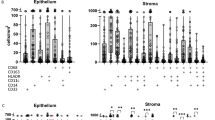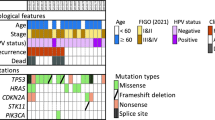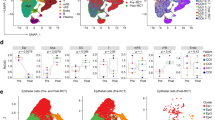Abstract
Background
Vulvar and vaginal melanoma (VuM & VaM) is a rare gynecologic malignancy with high mortality but low effectiveness to checkpoint immunotherapy compared to cutaneous melanoma. This article aims to elucidate the role of the disordered immune microenvironment in cancer progression in VuM.
Methods
At first, this article applied single-cell RNA sequencing (scRNA-seq) to the VuM obtained from a 68-year-old female patient, and constructed a single-cell atlas of VuM consist of 12,243 single cells. Then this article explores the genomic complexity and core signal channel in VuM microenvironment.
Results
This article provides new insights about the pathogenesis of VuM based on single-cell resolution data. It was found that the activation of CD8+ T cell contributed to induce tumor angiogenesis and immune escape, and the activation of the antigen-presenting molecular function participated in melanoma metastasis.
Conclusion
This article provided new insights into underlining VuM molecular regulation and potential signaling involved in immunotherapy, which would benefit the clinical practice and administration.
Similar content being viewed by others
Introduction
Melanoma originates from pigment-producing melanocytes, which can be found in the skin, eyes, inner ear and soft brain membranes. Genetic variants have been identified as a contributor in such a process. As a kind of malignant tumor, cutaneous malignant melanoma is considered the most aggressive (prone to spread) and fatal skin cancer with a collapsed prognosis which reveals a high possibility of metastasis, although it only accounts for 1% of all skin malignancies. Currently, an integrative therapeutic strategy has been applied in the administration of tumor, including surgical removal, chemotherapy, radiotherapy, photodynamic therapy, immunotherapy or cell therapy [1]. Immunotherapy presents great potential in the advanced management of malignant tumors, but the immune microenvironment is critical in deciding the outcomes of immunotherapy. Thus, beyond histological classification, immunological analysis would be essential for melanoma.
Based on histological analysis, VuM is predominantly superficially diffuse, nodular and acral freckle type, while VaM is predominantly nodular [2, 3]. Superficially diffuse melanoma demonstrates a relatively better prognosis, whereas nodular melanoma indicates a poor prognosis [2]. Generally, VuM and VaM are often subject to delayed diagnoses, and most cases remain undetected until they have progressed to an advanced stage. Female genital tract associated melanoma only consists of 1–3% affected population, and most of them are located in vulva area (76%) [4]. The five-year survival rate of VuM and VaM varies between 10% and 50% [5]. Moreover, a high ratio of local and distant metastases is usually identified in VuM patients, with a high incidence of drug resistance, indicating a terrible prognosis [2, 6].
scRNA-seq has its unique advantage of maximizing tissue heterogeneity owing to unbiased assessment of single-cell expression profile [41]. The challenges in eradicating melanoma stem from its inherent heterogeneity and adaptability. Melanoma exhibits significant heterogeneity in terms of cell composition, chromosomal structure, developmental trajectories, intercellular signaling networks, and phenotypic dominance. By analyzing metabolic gene expression profiles in the tumor microenvironment using single-cell expression data, researchers can uncover metabolic characteristics and pathways that distinguish tumor metabolic heterogeneity at the single-cell level from that at the tissue level. This approach enables the determination of tumor microenvironment heterogeneity by re-subty** and identifying cellular features, including phenotypic abundance, genetic alterations, immune dynamics, clonal expansion, developmental trajectories, and molecular interactions [42]. These factors have the potential to influence patient prognosis and treatment outcomes, providing invaluable insights into melanoma treatment strategies [43]. A significant portion (40-50%) of malignant melanoma arises from immune-related antigens, such as T cell-granulocyte expression of PD-1, CD8+, CD4+ T, and NK T lymphocyte-granulocytes. Combining PD-1/PD-L1 inhibitors with Toll-like receptor agonists has been extensively studied as a combination therapy in clinical practice. Immuno-infiltration therapy aims to enhance the immune response against tumor-associated antigens or autoantibodies. While T lymphocytes can directly eliminate tumor cells, it is crucial to disrupt the balance of CD8+ T and NK lymphocytes-granulocytes within the tumor to prevent malignant melanoma metastasis recurrence. This can be achieved by activating CD8+ T lymphocytes-granulocytes through antigen recognition receptors or ligands, a process known as anti-demethlicity. Another approach involves obtaining resistant T lymphocytes-granulocytes by adding or removing antigens in immunodeficient mouse allografts. PD-1/PD-L1 inhibitors have demonstrated efficacy in the treatment of non-metastatic melanoma and various other malignancies. Currently, PD-1/PD-L1 inhibitors are approved for the treatment of melanoma, bladder cancer, and other malignancies. Thus, the scRNA-seq revealed the significance of immune responses involved in cellular communication contributing to micro-environment formation in melanoma. And the cellular interaction induced several antigens’ high expression which participated in the immunological escape of cancer cells and the failure of chemical therapy. So, the identified results demonstrated the importance of immunological regulation or modification in melanoma management. Although this was only a case report which contained limited data and samples. However, the results still provided clinical implications but more than 10 thousand cellular interaction analysis, indicating a further research topic hitting the immunological regulation or immunotherapy in melanoma.
There are still many limitations in this study. Firstly, the sample size was relatively small, consisting of only one specimen. Furthermore, when comparing our data to other datasets such as The Cancer Genome Atlas (TCGA) and other single-cell datasets, it is crucial to consider potential confounding factors arising from technical and batch effects, emphasizing the need for cautious interpretation. To address these limitations, we plan to increase the sample size in our follow-up study to ensure the reproducibility of our conclusions. To further validate the critical role of CD8+ T cells, we will use PD-1/PD-L1 inhibitors to treat human VuM cells. By scratch assay and transwell invasion assay, we can verify the effect of CD8+Tcell on the VuM cells migration. Ho** experiment results provide a new reference for VuM targeting treatment.
Conclusion
In conclusion, the characterization of melanoma at the cellular and molecular levels has provided valuable insights into its heterogeneity, tumor microenvironment, and potential therapeutic targets. Studies examining single-cell expression data have revealed transcriptional signatures of various cell types, allowing for the identification of specific markers and pathways involved in melanoma progression and metastasis. Besides, the immunological microenvironmental regulation had been supposed to be involved in the formation and growth of melanoma, and corresponding molecules on the identified antigens presented a promising therapeutic strategy. Furthermore, the identification of genetic alterations, metabolic characteristics, and molecular interactions within the tumor microenvironment provides valuable information for personalized treatment approaches and prognostic predictions. l.
Data availability
The original contributions presented in the study are included in the article; further inquiries can be directed to the corresponding authors. The data that support the findings of this study have been deposited into the CNGB Sequence Archive (CNSA) of China National GeneBank DataBase (CNGBdb) with accession number CNP0004387.
References
Domingues B, Lopes JM, Soares P, Pópulo H. Melanoma treatment in review. ImmunoTargets and Therapy. 2018;7:35–49.
Wohlmuth C, Wohlmuth-Wieser I, May T, Vicus D, Gien LT, Laframboise S. Malignant melanoma of the Vulva and Vagina: a US Population-based study of 1863 patients. Am J Clin Dermatol. 2020;21(2):285–95.
Gadducci A, Carinelli S, Guerrieri ME, Aletti GD. Melanoma of the lower genital tract: prognostic factors and treatment modalities. Gynecol Oncol. 2018;150(1):180–9.
Ragnarsson-Olding B, Johansson H, Rutqvist LE, Ringborg U. Malignant melanoma of the vulva and vagina. Trends in incidence, age distribution, and long-term survival among 245 consecutive cases in Sweden 1960–1984. Cancer. 1993;71(5):1893–7.
Hou JY, Baptiste C, Hombalegowda RB, Tergas AI, Feldman R, Jones NL, Chatterjee-Paer S, Bus-Kwolfski A, Wright JD, Burke WM. Vulvar and vaginal melanoma: a unique subclass of mucosal melanoma based on a comprehensive molecular analysis of 51 cases compared with 2253 cases of nongynecologic melanoma. Cancer. 2017;123(8):1333–44.
Yu Y, Tse KY, Lee HHY, Chow KL, Tsang HW, Wong RWC, Cheung ETY, Cheuk W, Lee VWK, Chan WK, et al. Predictive biomarkers and tumor microenvironment in female genital melanomas: a multi-institutional study of 55 cases. Mod Pathology: Official J United States Can Acad Pathol Inc. 2020;33(1):138–52.
Li L, **ong F, Wang Y, Zhang S, Gong Z, Li X, He Y, Shi L, Wang F, Liao Q, et al. What are the applications of single-cell RNA sequencing in cancer research: a systematic review. J Experimental Clin cancer Research: CR. 2021;40(1):163.
Haque A, Engel J, Teichmann SA, Lönnberg T. A practical guide to single-cell RNA-sequencing for biomedical research and clinical applications. Genome Med. 2017;9(1):75.
Liu C, Li X, Huang Q, Zhang M, Lei T, Wang F, Zou W, Huang R, Hu X, Wang C et al. Single-cell RNA-sequencing reveals radiochemotherapy-induced innate immune activation and MHC-II upregulation in cervical cancer. Signal Transduct Target Therapy 2023, 8(1).
Liu C, Zhang M, Yan X, Ni Y, Gong Y, Wang C, Zhang X, Wan L, Yang H, Ge C, et al. Single-cell dissection of cellular and molecular features underlying human cervical squamous cell carcinoma initiation and progression. Sci Adv. 2023;9(4):eadd8977.
Kanehisa M. Toward understanding the origin and evolution of cellular organisms. Protein Sci. 2019;28(11):1947–51.
Kanehisa M, Furumichi M, Sato Y, Kawashima M, Ishiguro-Watanabe M. KEGG for taxonomy-based analysis of pathways and genomes. Nucleic Acids Res. 2023;51(D1):D587–d592.
Kanehisa M, Goto S. KEGG: kyoto encyclopedia of genes and genomes. Nucleic Acids Res. 2000;28(1):27–30.
Coussens LM, Werb Z. Inflammation and cancer. Nature. 2002;420(6917):860–7.
DiLillo DJ, Yanaba K, Tedder TF. B cells are required for optimal CD4 + and CD8 + T cell tumor immunity: therapeutic B cell depletion enhances B16 melanoma growth in mice. J Immunol (Baltimore Md: 1950). 2010;184(7):4006–16.
Chi P, Jiang H, Li D, Li J, Wen X, Ding Q, Chen L, Zhang X, Huang J, Ding Y. An immune risk score predicts progression-free survival of melanoma patients in South China receiving anti-PD-1 inhibitor therapy-a retrospective cohort study examining 66 circulating immune cell subsets. Front Immunol. 2022;13:1012673.
Potrony M, Carreras E, Aranda F, Zimmer L, Puig-Butille JA, Tell-Marti G, Armiger N, Sucker A, Gimenez-Xavier P, Martinez-Florensa M, et al. Inherited functional variants of the lymphocyte receptor CD5 influence melanoma survival. Int J Cancer. 2016;139(6):1297–302.
Ladányi A. Prognostic and predictive significance of immune cells infiltrating cutaneous melanoma. Pigment cell & Melanoma Research. 2015;28(5):490–500.
Allavena P, Sica A, Solinas G, Porta C, Mantovani A. The inflammatory micro-environment in tumor progression: the role of tumor-associated macrophages. Crit Rev Oncol/Hematol. 2008;66(1):1–9.
Fregni G, Perier A, Avril MF, Caignard A. NK cells sense tumors, course of disease and treatments: consequences for NK-based therapies. Oncoimmunology. 2012;1(1):38–47.
Karlen SJ, Miller EB, Wang X, Levine ES, Zawadzki RJ. Burns MEJJon: monocyte infiltration rather than microglia proliferation dominates the early immune response to rapid photoreceptor degeneration. 2018, 15(1):1–16.
Zhou S, Liang Y, Zhang X, Liao L, Yang Y, Ouyang W, Xu HJ. SHARPIN promotes melanoma progression via Rap1 signaling pathway. JoID. 2020;140(2):395–403. e396.
Stoebner PE, Lavabre-Bertrand T, Henry L, Guiraud I, Carillo S, Dandurand M, Joujoux JM, Bureau JP. Meunier LJBJoD: high plasma proteasome levels are detected in patients with metastatic malignant melanoma. 2005, 152(5):948–53.
Jiang S, Li M, Hu Y, Zhang Z, Lv H. Multifunctional self-assembled micelles of galactosamine-hyaluronic acid-vitamin E succinate for targeting delivery of norcantharidin to hepatic carcinoma. Carbohydr Polym. 2018;197:194–203.
Hu C, Ni Z, Li BS, Yong X, Yang X, Zhang JW, Zhang D, Qin Y, Jie MM, Dong H, et al. hTERT promotes the invasion of gastric cancer cells by enhancing FOXO3a ubiquitination and subsequent ITGB1 upregulation. Gut. 2017;66(1):31–42.
Cheng N, Brantley D, Fang WB, Liu H, Fanslow W, Cerretti DP, Bussell KN, Reith A, Jackson D, Chen J. Inhibition of VEGF-dependent multistage carcinogenesis by soluble EphA receptors. Neoplasia. 2003;5(5):445–56.
Gauthier T, Uzan C, Gouy S, Kane A, Calvacanti A, Mateus C, Robert C, Kolb F, Morice P. [Malignant melanoma of the vagina: pejorative location]. Gynecologie Obstetrique & Fertilite. 2012;40(5):273–8.
Göbel J, Košťál M, Hensel G, Hátlová J. Primary malignant melanoma of the vagina, case report and review of the literature. Ceska Gynekol. 2018;83(3):201–199.
Vaysse C, Pautier P, Filleron T, Maisongrosse V, Rodier JF, Lavoue V, Reyal F, Thomas L, de la Fouchardière A, Delannes M. A large retrospective multicenter study of vaginal melanomas: implications for new management. Melanoma Res. 2013;23(2):138–46.
To C, Farnsworth RH, Vail ME, Chheang C, Gargett CE, Murone C, Llerena C, Major AT, Scott AM, Janes PW, et al. Hypoxia-controlled EphA3 marks a human endometrium-derived multipotent mesenchymal stromal cell that supports vascular growth. PLoS ONE. 2014;9(11):e112106.
Balakrishnan A, Bleeker FE, Lamba S, Rodolfo M, Daniotti M, Scarpa A, van Tilborg AA, Leenstra S, Zanon C, Bardelli A. Novel somatic and germline mutations in cancer candidate genes in glioblastoma, melanoma, and pancreatic carcinoma. Cancer Res. 2007;67(8):3545–50.
Lawrenson ID, Wimmer-Kleikamp SH, Lock P, Schoenwaelder SM, Down M, Boyd AW, Alewood PF, Lackmann M. Ephrin-A5 induces rounding, blebbing and de-adhesion of EphA3-expressing 293T and melanoma cells by CrkII and rho-mediated signalling. J Cell Sci. 2002;115(Pt 5):1059–72.
Kuijper S, Turner CJ, Adams RH. Regulation of angiogenesis by eph-ephrin interactions. Trends Cardiovasc Med. 2007;17(5):145–51.
Jungwirth U, van Weverwijk A, Evans RJ, Jenkins L, Vicente D, Alexander J, Gao Q, Haider S, Iravani M, Isacke CM. Impairment of a distinct cancer-associated fibroblast population limits tumour growth and metastasis. Nat Commun. 2021;12(1):3516.
Buechler MB, Pradhan RN, Krishnamurty AT, Cox C, Calviello AK, Wang AW, Yang YA, Tam L, Caothien R, Roose-Girma M, et al. Cross-tissue organization of the fibroblast lineage. Nature. 2021;593(7860):575–9.
Luo H, Tu G, Liu Z, Liu M. Cancer-associated fibroblasts: a multifaceted driver of breast cancer progression. Cancer Lett. 2015;361(2):155–63.
Chen X, Song E. Turning foes to friends: targeting cancer-associated fibroblasts. Nat Rev Drug Discovery. 2019;18(2):99–115.
Koopmans T, Rinkevich Y. Mesothelial to mesenchyme transition as a major developmental and pathological player in trunk organs and their cavities. Commun Biology. 2018;1:170.
Aslam MI, Abraham J, Mansoor A, Druker BJ, Tyner JW, Keller C. PDGFRβ reverses EphB4 signaling in alveolar rhabdomyosarcoma. Proc Natl Acad Sci USA. 2014;111(17):6383–8.
Hadjimichael AC, Pergaris A, Kaspiris A, Foukas AF, Kokkali S, Tsourouflis G, Theocharis S. The EPH/Ephrin System in Bone and Soft Tissue Sarcomas’ Pathogenesis and Therapy: New Advancements and a Literature Review. Int J Mol Sci 2022, 23(9).
Girard CA, Lecacheur M, Ben Jouira R, Berestjuk I, Diazzi S, Prod’homme V, Mallavialle A, Larbret F, Gesson M, Schaub S, et al. A feed-Forward Mechanosignaling Loop confers resistance to therapies targeting the MAPK pathway in BRAF-Mutant Melanoma. Cancer Res. 2020;80(10):1927–41.
Tirosh I, Izar B, Prakadan SM, Wadsworth MH 2nd, Treacy D, Trombetta JJ, Rotem A, Rodman C, Lian C, Murphy G, et al. Dissecting the multicellular ecosystem of metastatic melanoma by single-cell RNA-seq. Sci (New York NY). 2016;352(6282):189–96.
Gong L, Kwong DL, Dai W, Wu P, Li S, Yan Q, Zhang Y, Zhang B, Fang X, Liu L, et al. Comprehensive single-cell sequencing reveals the stromal dynamics and tumor-specific characteristics in the microenvironment of nasopharyngeal carcinoma. Nat Commun. 2021;12(1):1540.
Acknowledgements
Not applicable.
Funding
This work was supported by grants from Technology Project of Sichuan Province of China (2021YFQ0061) and the National Natural Science Foundation of China (82270249). The funding did not participate in the design of the study and collection, analysis, and interpretation of data and in writing the manuscript.
Author information
Authors and Affiliations
Contributions
XW, JL and YL contributed equally to this work. TG and YL were the patient’s physicians. XW, JL and ML reviewed the literature and contributed to manuscript drafting; ZF, TG and YL conceptualized and designed the study, coordinated and supervised data collection, and critically reviewed the manuscript for important intellectual content. ZF and TG were responsible for the revision of the manuscript for important intellectual content.
Corresponding authors
Ethics declarations
Ethical approval
This study was approved by the Ethics Committee of West China Second Hospital of Sichuan University (2014-034). We obtained the written informed consent to participate in this research from the patient.
Consent for publication
For this patient, written informed consent was obtained from the patient for publication of this Case report and any accompanying images. And we also obtained the written informed consent from her son involved in this study for publication of related clinical data. A copy of the written consent is available for review by the Editor of this journal.
Competing interests
The authors declare no competing interests.
Additional information
Publisher’s Note
Springer Nature remains neutral with regard to jurisdictional claims in published maps and institutional affiliations.
Electronic supplementary material
Below is the link to the electronic supplementary material.
Rights and permissions
Open Access This article is licensed under a Creative Commons Attribution 4.0 International License, which permits use, sharing, adaptation, distribution and reproduction in any medium or format, as long as you give appropriate credit to the original author(s) and the source, provide a link to the Creative Commons licence, and indicate if changes were made. The images or other third party material in this article are included in the article’s Creative Commons licence, unless indicated otherwise in a credit line to the material. If material is not included in the article’s Creative Commons licence and your intended use is not permitted by statutory regulation or exceeds the permitted use, you will need to obtain permission directly from the copyright holder. To view a copy of this licence, visit http://creativecommons.org/licenses/by/4.0/. The Creative Commons Public Domain Dedication waiver (http://creativecommons.org/publicdomain/zero/1.0/) applies to the data made available in this article, unless otherwise stated in a credit line to the data.
About this article
Cite this article
Wang, X., Li, J., Li, Y. et al. Single-cell analysis of the cellular landscape of vulvar melanoma provides new insight for immunotherapy administration. BMC Cancer 24, 101 (2024). https://doi.org/10.1186/s12885-024-11839-0
Received:
Accepted:
Published:
DOI: https://doi.org/10.1186/s12885-024-11839-0




